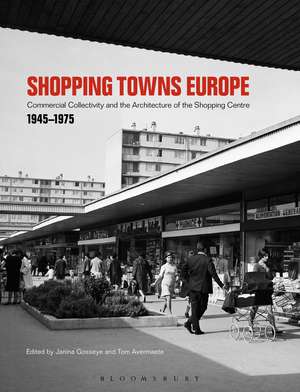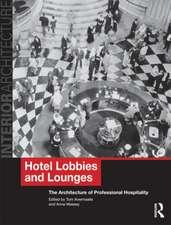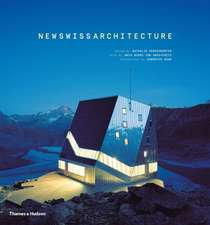Shopping Towns Europe: Commercial Collectivity and the Architecture of the Shopping Centre, 1945–1975
Editat de Janina Gosseye, Tom Avermaeteen Limba Engleză Hardback – 25 ian 2017
| Toate formatele și edițiile | Preț | Express |
|---|---|---|
| Paperback (1) | 226.12 lei 3-5 săpt. | |
| Bloomsbury Publishing – 5 feb 2020 | 226.12 lei 3-5 săpt. | |
| Hardback (1) | 777.47 lei 6-8 săpt. | |
| Bloomsbury Publishing – 25 ian 2017 | 777.47 lei 6-8 săpt. |
Preț: 777.47 lei
Preț vechi: 1115.09 lei
-30% Nou
Puncte Express: 1166
Preț estimativ în valută:
148.79€ • 161.56$ • 124.98£
148.79€ • 161.56$ • 124.98£
Carte tipărită la comandă
Livrare economică 22 aprilie-06 mai
Preluare comenzi: 021 569.72.76
Specificații
ISBN-13: 9781474267373
ISBN-10: 1474267378
Pagini: 272
Ilustrații: 85 bw illus
Dimensiuni: 189 x 246 x 18 mm
Greutate: 0.73 kg
Editura: Bloomsbury Publishing
Colecția Bloomsbury Academic
Locul publicării:London, United Kingdom
ISBN-10: 1474267378
Pagini: 272
Ilustrații: 85 bw illus
Dimensiuni: 189 x 246 x 18 mm
Greutate: 0.73 kg
Editura: Bloomsbury Publishing
Colecția Bloomsbury Academic
Locul publicării:London, United Kingdom
Caracteristici
An original topic: numerous publications focus on the history of the shopping centre in the USA, but until now no study has taken its European counterpart as a focal point in equivalent depth
Notă biografică
Janina Gosseye is a postdoctoral research fellow at TUDelft, the Netherlands, and a member of the ATCH at the University of Queensland, Australia. She has co-edited several books, including Hot Modernism: Queensland Architecture 1945-1975 (2015), Water Urbanisms (2008), Reclaiming (the Urbanism of) Mumbai (2009) and The Specific and the Singular - Architecture in Flanders (2010). Tom Avermaete is professor of architecture at TU Delft, the Netherlands. He is the author of Another Modern: the Post-War Architecture and Urbanism of Candilis-Josic-Woods (2005), and co-editor of Colonial Modern: Aesthetics of the Past, Rebellions for the Future (2010) and Structuralism Reloaded: Rule-Based Design in Architecture and Urbanism (2011).
Cuprins
Introduction1. Urbanism harnessing the consumption-juggernaut: Shopping centres and urban (re-)development Shopping à l'américaine, Kenny CupersThe 1960s Shopping Centre Grid of Helsinki, Juhana LahtiShopping Centres as Catalysts for New Multifunctional Urban Centralities, Yannick Vanhaelen and Géry LeloutreThe Lijnbaan in Rotterdam, Dirk van den HeuvelDisplays of Modernity, Jasna Mariotti2. Constructing consumer-citizens: Shopping centres shaping commercial collectivityMiracles and Ruins, Citizens and Shoppers, Inderbir Singh RiarCollectivity in the Prison of Plenty, Tom AvermaeteHello Consumer!. Jennifer MackMilton Keynes' Centre, Janina GosseyeShopping as a Part of Political Agenda, Sanja Matijevic Barcot and Ana GrgicUnico Prezzo Italiano, Daniele Vadala3. Between dense and tall and the low-slung (suburban) shopping mallThe Creation of Civic Identity in Post-war Corporate Architecture, Evangelia TsilikaThe Shopping Centre Comes to Germany, Steffen de RudderBuilt for Mass Consumption, Olaf GisbertzThe Drive to Modernise, Jo LintonbonMalls and Commercial Planning Policies in a Compact City, Nadia Fava and Manel Guardia Bassols
Recenzii
A methodologically refreshing intervention that nevertheless manages to be entirely part of an ongoing historiographical moment. This is very much to its credit, and the novel perspective it offers is likely to prove enlightening to historians of modern architecture, of mass consumption, and most especially of Modern Europe.
This valuable collection shows how civic and commercial agendas converged in the urban planning and architecture of new shopping centers throughout Europe in the decades after World War II. It makes a compelling case that these places helped shape a "pervasive modernity," albeit one that could not, in itself, reconcile the values of collective societies with the juggernaut of consumer culture.
Shopping Towns Europe is a tour de force of pan-European research collaboration. It draws together scholarship from all over Europe to overturn the usual story of the American origins of the shopping mall, completely changing our understanding of this new urban building type.
The book fills a remarkable gap in the historiography of postwar European architecture. Avermaete and Gosseye have done a splendid job in bringing together scholars from all over Europe. A valuable book that enriches our understanding of a crucial period.
This valuable collection shows how civic and commercial agendas converged in the urban planning and architecture of new shopping centers throughout Europe in the decades after World War II. It makes a compelling case that these places helped shape a "pervasive modernity," albeit one that could not, in itself, reconcile the values of collective societies with the juggernaut of consumer culture.
Shopping Towns Europe is a tour de force of pan-European research collaboration. It draws together scholarship from all over Europe to overturn the usual story of the American origins of the shopping mall, completely changing our understanding of this new urban building type.
The book fills a remarkable gap in the historiography of postwar European architecture. Avermaete and Gosseye have done a splendid job in bringing together scholars from all over Europe. A valuable book that enriches our understanding of a crucial period.









